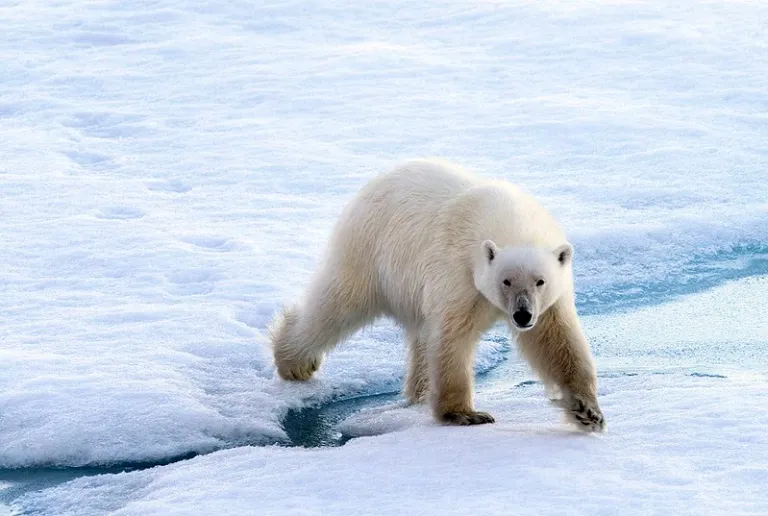The Polar Challenge Game for EL Collaboration
You may have played the “desert island” game before: You’re put in a group and asked to work together to choose a limited number of items you’d want to have with you if you were stuck on a desert island together.
As the weather here in New England gets colder, I like to play a variation on this game called the Polar Challenge, in which my students are “sent” to a secret location above the Arctic Circle for 2 years as punishment for an imaginary crime. As in the desert island game, the idea is for groups to work together to figure out what they will need to survive in a remote area.

“Polar Bear” by Christopher Michel, (CC BY 2.0)
The following instructions are intended for high-intermediate to advanced students. To adjust for time and level, shorten the list and reduce or eliminate unfamiliar vocabulary.
Set the Scene
First, the students need to know something about where they are going. Following are some important facts about this secret area:
- There is plenty of snow. However, there are no plants except for roughly three trees (each 2 meters tall) per 10 square kilometers.
- The temperature is below zero Celsius all year.
- It is dark half of the year and light the other half. At the time of class, it is light.
- Animals in that area include small arctic foxes and huge, dangerous polar bears on land; whales, seals, and fish in the ocean; and many small birds that nest near the water.
- There is no cell phone reception and no chance of escape.
Establish the Rules
Each group of students is allowed to take the clothes they are wearing, but no other personal items.
Each group member will also receive a heavy coat; bowl, fork and spoon; 7 kilos of chocolate; and a water bottle (water not included).
In addition, they may choose 12 items from the list in the following section to take with them. Many of these items are separate. For instance, the flashlight does not include batteries.
Unless specified, there is only one item (for example, one tent) that must be shared by the group. In this list, the items are in rough groups, such as tools and clothing. I allow students to use the internet to look up unfamiliar vocabulary.
Students should focus on finding food, clothing, and shelter. If the students can survive for 2 years, they will be set free. There are no wrong answers, and creativity is encouraged.
Make a List
Here is a sample list of 30 items for students to choose from.
- 400 matches
- 30 candles (10 hours each)
- 10 extra batteries (each one lasts 20 hours)
- flashlight (needs batteries)
- 30 liters of fuel (each liter runs the heater for 10 hours)
- heater (needs fuel)
- rifle
- club
- sword
- harpoon
- 3 small knives
- ammunition for rifle (250 bullets)
- magnifying glass
- whistle
- 1 can opener
- shovel
- fishing rod and hook (can catch fish up to 20 kilos)
- Large sled
- Kayak and paddle
- tent
- sleeping bag (1 for each person)
- beef jerky (80 kilos)
- 100 cans of food (120 kilos. Needs a can opener)
- 20 spools of heavy thread and 20 needles
- 100 meters of rope
- solar powered walkie-talkie (set of 2)
- backpack (1 for each person)
- instruction book for camping in the snow (in your native language)
- snow boots (1 pair for each person)
- waders and wading boots (2 pairs)
Assign Roles
Assign three to five students to each group (or online breakout room) and give students roles, such as facilitator, time-keeper, note-taker, and reporter. You can find more ideas on promoting good discussions in my October Blog. Give students a time limit based on the number of items. For 30 items, I allow students 40 minutes to deliberate. Check in with groups periodically to answer questions and help the facilitator encourage everyone to participate.
Debrief
After the time is up, bring students back together and ask them to explain which 12 items they chose and why. It’s interesting to see what strategy each group chooses for surviving the harsh conditions.
Whether or not it’s cold where you are, I hope your students have fun playing in the imaginary snow of this activity. Are there any activities you like to do seasonally? Please share in the comments below.

About the author
A. C. Kemp
A. C. Kemp has been a lecturer in English language studies at MIT since 2007. She has a master’s degree in applied linguistics from the University of Massachusetts/Boston. A. C. has also presented extensively on teaching strategies for vocabulary acquisition. Since 2002, she has been the director of Slang City, a website devoted to American slang and colloquial language. She also has a strong interest in ITA training, for which she created the User-Friendly Classroom Video Series in 2016.